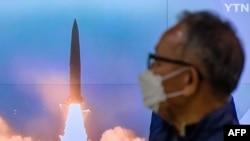North Korea has conducted an uncommon late-night missile test on the eve of an anniversary marking the founding of its Workers’ Party.
The test came hours after a U.S. aircraft carrier task force wrapped up a second week of naval exercises with South Korea. The carrier’s return to waters off the Korean peninsula – prompted by North Korea’s launch of an intermediate-range ballistic missile over Japan - was characterized by Pyongyang as “of considerably huge negative splash to the regional situation.”
Two short-range ballistic missiles were fired between 1:48 and 1:58 a.m. Sunday, South Korea’s military said, from the Munchon area into the East Sea, also known as the Sea of Japan. They flew 350 kilometers and reached a top altitude of 90 kilometers, it added.
Japan’s Senior Vice Defense Minister Toshiro Ino announced similar figures. He said the missiles, after being launched at around 1:47 a.m. and 1:53 a.m., landed outside Japan’s exclusive economic zone after gliding some 350 kilometers at an apogee of 100 kilometers. The possibility they were submarine-launched ballistic missiles was being studied, he said.
Munchon, located along North Korea’s eastern coast, hosts a naval base that in 2016 was seen undergoing renovation.
Analysts in Seoul, however, noted similarities in Sunday’s launches to a tactical ballistic missile, known to U.S. authorities as the KN-25, or what North Korean media have in the past called the “super-large” multiple rocket launch system. It was thought to be one of two missiles tested last Thursday, hours after the USS Ronald Reagan had been rerouted for a second round of naval exercises with South Korea and Japan.
In an emergency meeting, South Korea’s National Security Council strongly condemned the continuing launch of short- and intermediate-range missiles as destabilizing acts that violate United Nations Security Council resolutions. Sunday’s ballistic missile launching is the seventh in 15 days, extending a record run of weapons testing this year.
The U.S. Indo-Pacific Command, in its assessment, said the latest launch did not pose an immediate threat to the U.S. or its allies, while affirming the U.S.’s “ironclad” commitments to the defense of South Korea and Japan.
Sunday’s test precedes the 77th anniversary of the founding of North Korea’s only political party, the Workers’ Party, on Monday. South Korean officials have said North Korea could be preparing a weapons showcase, though a weapons parade like those that occur every five years is viewed as unlikely.
North Korea signals more tests
North Korea has not published a state media report on its missile tests the day after they are conducted since May 2022.
Instead, its official Korean Central News Agency (KCNA) over the weekend issued two statements from spokespeople from its Defense Ministry and its National Aviation Administration, both suggesting that launches would continue.
The redeployment of the “nuclear-powered carrier task force… [was an] extremely worrisome development of the present situation,” a spokesperson of North Korea’s Ministry of Defense said via KCNA on Saturday, calling it “military bluffing” to Pyongyang’s “righteous reaction” to military drills between South Korea and the U.S.
In a more substantial KCNA article, also Saturday, North Korea’s National Aviation Administration spokesperson defended Tuesday’s alarming missile flight over Japan, claiming “civil aircraft safety was fully considered in advance” and that the launch was part of a “regular and planned self-defensive step [against] U.S. direct military threats.”
The two comments came in reaction to condemnation by the U.N.-affiliated International Civil Aviation Organization Friday, which North Korea dismissed as “political provocation of the U.S. and its vassal forces.”
Pressure raised as nuclear test anticipated
Pressure continues to mount on parties assisting the nuclear-armed state. The United States Treasury Department on Friday issued additional sanctions against two individuals and three entities based in Singapore and the Marshall Islands with suspected ties to North Korea’s arms program.
Additionally, in a phone call last week, special envoys for North Korea from the U.S., Japan and South Korea committed to bolstering efforts to disrupt North Korea’s cryptocurrency theft, according to Seoul’s foreign ministry.
Despite crippling economic sanctions weighing on state coffers, Pyongyang has managed to amass a cash pile worth hundreds of millions of dollars just in the first half of the year, the United Nations Security Council sanctions committee said in a midterm report Friday. The committee noted multimillion-dollar heists of the cryptocurrency ether and North Korea’s exploitation of non-fungible token (NFT) technology.
No meaningful talks anticipated soon
Although Washington has maintained that the line to dialogue without preconditions with Pyongyang remains open, experts do not anticipate North Korea will show up for meaningful negotiations until it has achieved some ambitious military goals.
“North Korea’s leadership has no other strategic card other than playing the same game that it played in 2017 and 2018,” said Bong Youngshik, research fellow at Yonsei University’s Institute for North Korean Studies.
But knowing that U.S. President Joe Biden’s approach is vastly different from that of former President Donald Trump, North Korea now has its focus squarely on building a strategic upper hand – that is, by realizing key goals to upgrade its arsenal as previously announced in a key party congress, Bong said.
“Only after the successful completion of its military modernization program will it play the same game again, when it is armed with strategic assets, which will take another two to three years,” Bong predicted.
Among the five major weapons systems outlined at North Korea’s Eighth Party Congress in January of last year are multiple rocket launchers, tactical nuclear weapons, nuclear-powered submarines, supersonic missiles and maneuverable reentry vehicles. Also known by the acronym MaRV, these ballistic missiles are designed to hit ground targets autonomously.










